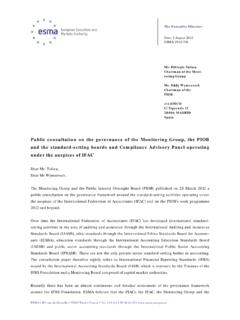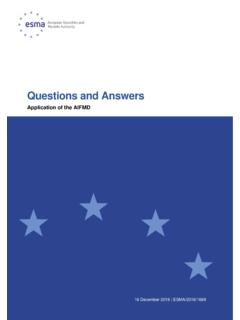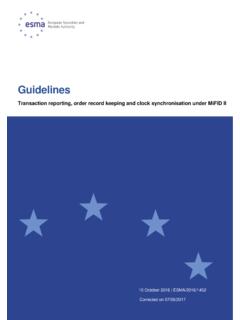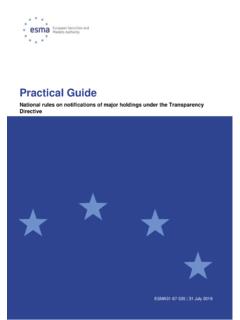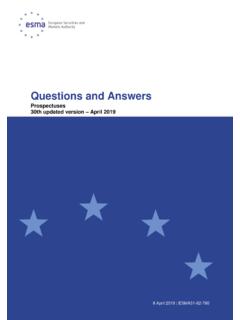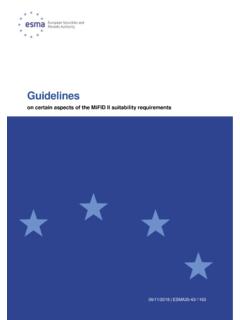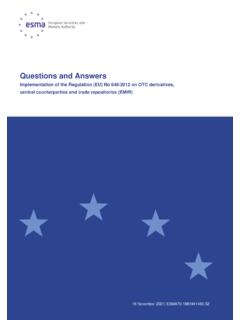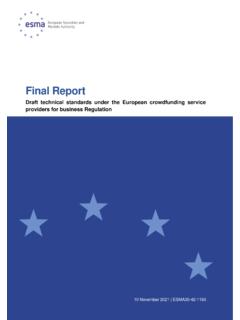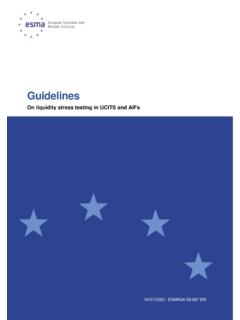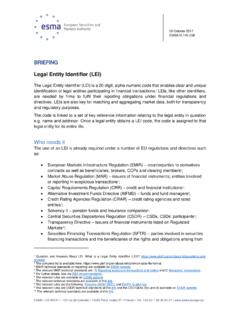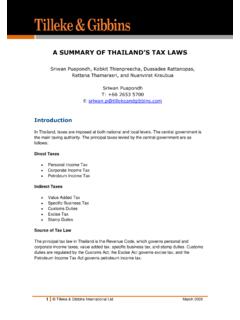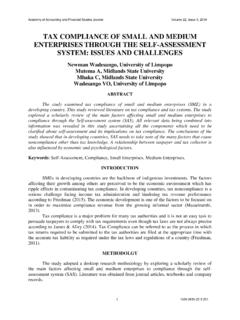Transcription of Ref: ESMA response to the Commission consultation on the ...
1 The Chair ESMA 201-203 rue de Bercy CS 80910 75589 Paris Cedex 12 France Tel. +33 (0) 1 58 36 43 21 Mr John Berrigan Director General Directorate-General Financial Stability, Financial Services and Capital Markets Union European Commission Rue de Spa 2 B - 1000 Brussels Belgium Ref: ESMA response to the Commission consultation on the Listings Act Dear Mr Berrigan, ESMA welcomes the Commission s targeted consultation on the Listings Act and would like to take this opportunity to share our views on adjusting different parts of the regulatory framework to facilitate better access to capital for small and medium -sized Enterprises ( smes ) and making public capital markets more attractive for EU companies, while also ensuring strong investor protection. The annex to this letter contains some more targeted responses to the Commission s consultation questions relevant to ESMA, but in addition we wish to convey in this letter some overarching remarks.
2 This consultation comes at an opportune moment for the EU to reflect on the current framework, as EU businesses continue to face challenges posed most recently by the COVID-19 pandemic, but at the same time as notable progress is being made on other parts of the CMU agenda. While the EU s capital markets have integrated steadily in the past four decades, they remain less developed than in other major jurisdictions. EU businesses continue to heavily rely on bank financing, with less than one-third of businesses securing finance from the EU s capital markets. In comparison, almost two-thirds of US businesses are financed through the US capital market. With the UK s departure from the EU and considering that the UK is currently reforming its primary markets rules, we believe it is right to give further impetus to the CMU agenda now and to review the EU s listing rules, amongst others. To develop sound, effective and globally attractive EU markets, we firmly support the need to further develop the EU s capital markets and mobilise more financing opportunities to benefit smes and other companies and stimulate sound and sustainable economic growth in the EU.
3 By improving access to EU capital markets for smes , and improving the overall attractiveness of EU capital markets, retail investors will in turn be empowered by increased choice to diversify their savings and investments. In this context it is important to ensure that the initial and ongoing costs for listing, as well as the degree of regulation, is proportionate and balanced. Nonetheless, strong investor protection is a prerequisite for retail participation and the basis to 15 February 2022 ESMA24-436-1152 2 maintain trust in our financial system, so any consideration for reducing regulatory burdens on issuers must be measured against that consideration. New and diversified funding sources, in particular equity funding, for smes and other companies are key to spurring growth and employment, efficiently allocating capital, and sharing risks. While the regulatory framework in place regarding listing activities is strong and effective, there is scope to streamline certain rules and find ways to carefully alleviate certain burdens for issuers, which may in turn reduce costs and enhance incentives for listing.
4 Of course, any adjustments in the regulatory framework must continue to be done in a harmonised way to allow for strong convergence of the supervision and enforcement of those rules. With that in mind, we wish to convey some overarching views in relation to key aspects of the consultation . Firstly, the purpose of the Prospectus Regulation is to ensure the proper disclosure of information when securities are offered to the public or admitted to trading on a regulated market. The scrutiny and approval of prospectuses helps to ensure market confidence in primary market transactions. These functions must be considered when determining whether there is a proper balance between investor protection and the burdens placed upon issuers. One clear benefit is that the Prospectus Regulation allows issuers to make offers of securities to the public throughout the Union thanks to the passporting mechanism. It is also important to recognise that, while there may be areas in which the administrative burdens included in the Prospectus Regulation can be alleviated, such alleviations are not necessarily likely to be effective without further changes to the ecosystem in which issuers operate.
5 For example, ESMA notes that there are other factors than regulation that are leading European businesses to seek funding outside of the capital markets, such as the relatively easy access to private financing and the preferential tax treatment given to debt. It is important to note that the Prospectus Regulation entered into application on 21 July 2019 and introduced a number of substantial changes, including new prospectus formats intended to alleviate administrative burdens on issuers, such as the EU growth prospectus and the simplified disclosure regime for secondary issuances. It may therefore be too early to draw definitive conclusions about all these changes, while the current rules are being embedded and stabilised. Furthermore, ESMA notes that the different disclosure regimes appear to work well, and the diversity of these regimes is one of the strengths of the Prospectus Regulation because it provides issuers with a toolkit to choose the format that best fits their circumstances and the nature of the transaction at hand.
6 As required by the Prospectus Regulation, ESMA is currently carrying out a peer review on the scrutiny and approval of prospectuses, which aims at evaluating the efficiency, methods, and timing of the scrutiny by the competent authorities of the information given in a prospectus, in order to foster further supervisory convergence. Additionally, the peer review aims at assessing the impact of different approaches to the scrutiny and approval of prospectuses on issuers ability to raise capital in the Union. For this reason, ESMA s responses to the questionnaire do not address the questions concerning the scrutiny and approval of prospectuses. ESMA expects to publish its final report on this peer review in July 2022. 3 Considering the scope of this peer review, ESMA recommends that the Commission awaits the outcome of that exercise and takes account of its findings for any potential amendments to the Prospectus Regulation concerning scrutiny and approval.
7 Secondly, ESMA s statement in relation to Special Purpose Acquisition Vehicles (SPACs) in July 2021 noted the significant rise in SPAC activity in the past year, and the resulting growing interest from investors1. While SPACs may contribute positively to the equity financing of smes , the complexity of SPAC transactions and associated risks means that SPAC shares and warrants may not be suitable investments for retail investors. It is therefore important that any future rule changes concerning SPACs take account of the importance of appropriate disclosure requirements and investor protection, as outlined in the ESMA statement. In this regard, the Commission may want to consider whether it would be useful to include specific disclosure requirements for SPACs. Thirdly, in the area of corporate governance, the consultation aims to review the use of multiple voting right share structures as a potential tool to encourage companies to list on public markets.
8 In ESMA s view, as outlined in our 2019 Advice on Short-Termism, to date there is not much evidence to indicate that multiple voting shares are effective in providing such incentives and a proper assessment would be beneficial. At the same time, multiple voting right share structures may be relevant for the competitive position of the EU vis- -vis other major international financial centres. However, if any changes were to be put forward in relation to multiple voting right share structures, they should be complemented by certain safeguards for investors including, for example, a harmonised maximum ratio between voting rights and cash-flow rights (wedge ratio). In relation to corporate governance standards for companies listed on SME growth markets, ESMA understands that establishing certain minimum safeguards may provide more reassurance to investors. However, such standards should be proportionate when compared to existing standards for listed companies on regulated markets and they should not prevent stock exchanges from setting listing requirements, also based on national specificities.
9 Fourthly, we take note of the questions in the consultation considering further alleviation to the research unbundling regime in MiFID II. In light of the extensive analysis already conducted by ESMA on this issue2, we would not believe that further alleviation to this regime, in addition to the exemption already introduced by the Capital Markets Recovery Package, is necessary. In fact, we deem these rules to have addressed a fundamental problem of conflict of interest without clear evidence of any detrimental effects on the availability and quality of research on EU companies (including smes ), as well as on company financing conditions. On the other hand, we would see merit in reviewing the framework for sponsored research. Sponsored research could help foster the coverage of smes ; however, for this field to develop in full, it may be necessary to clarify the conditions under which sponsored research may qualify as investment research and not as marketing material.
10 In this context, strict rules are needed to 1 ( ) 2 ESMA 50-165-1269 Research unbundling working paper ( ) 4 ensure its independence and objectivity, which could require more specific requirements than those currently in place. Additionally, we take note of the questions in the consultation concerning the Market Abuse Regulation (MAR), relating to inside information, managers transactions, insider lists, market sounding, sanctions and liquidity contract, and questions concerning MiFID II, relating to the registration of a segment of an MTF as an SME growth market, dual listings and equity research coverage of smes . ESMA has already addressed many of these questions, so we therefore refer you to our MAR Review Report3 and our MiFID II review report on the functioning of the regime for SME Growth Markets4. With specific reference to MAR, we are convinced that any form of facilitation of companies access to EU markets should not come at the detriment of the rules established to combat market abuse.
